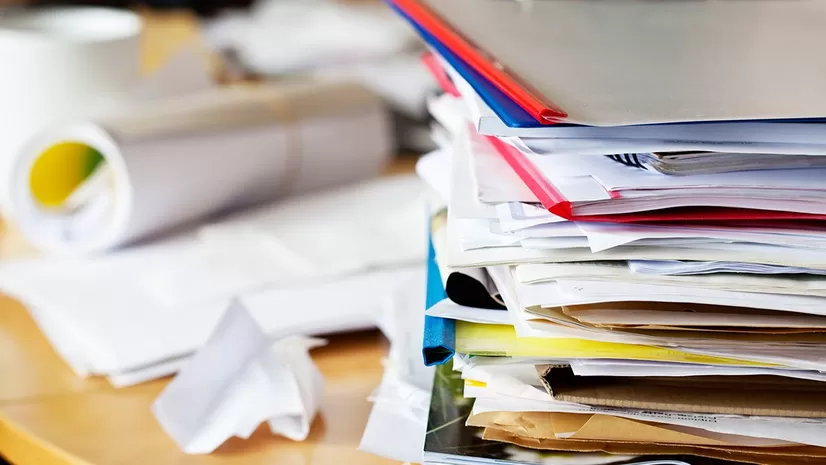
Are you sick of living among an endless jumble of loose papers? You’re not alone.
Plenty of people share the type of dismay you feel when you see stacks of paper bills, store receipts, and discarded junk mail strewed about your home. You know that irritating collection of paperwork shouldn’t be occupying precious real estate on your home’s otherwise usable surfaces like your dining table and countertops, but curbing the clutter can be tough.
For this installment of our “Decluttering for Dummies” series, we asked expert organizers to share their best tips on reducing your paper piles and reclaiming your home office, kitchen, entryway, or wherever those dusty piles of documents have been living.
First things first: Sort the papers
This first tip might seem obvious, but it needs to be said: You need to make this overwhelming process seem a bit less so, and the best way to do that is to organize your multitude of papers into functional piles.
“Do a first pass of paperwork to decide what’s truly trash and which items require some sort of action,” says Rebecka Jodeit of Graceful Spaces Organizing.
From there, grab the stack of papers that require action and sort them into the following categories: to pay, to keep in sight, to file. Then, when you have time, you can tackle each stack of papers and take the appropriate action.
Put aside essential documents
Your essential documents will be part of the “to file” stack, and you’ll want to store them somewhere safe. These essential documents will include items like contracts, medical records, paperwork for taxes, and any official or government-issued documents like birth certificates, passports, and wills.
If you’re having a hard time deciding what’s truly essential and what isn’t, professional organizer Amy Trager suggests you ask yourself these questions. Would you reference this piece of paper again? Is it available in some other format (digitally or at the library)? Are there legal or medical reasons to keep it?
Go digital
Once you have some piles of things you intend to keep, it’s time to consider if you can digitize those items and throw away the originals. Use a scanner to save a digital copy of the paper on your computer, or snap a photo of the document on your phone.
“There are so many apps to help with paperwork going digital,” says Molly Govus of Beespoked. “Apple Wallet and Files are great for storing documents you’ll need at your fingertips, from travel documents to event tickets. Dropbox and Google Drive offer cloud storage, which is great for photos and large files.”
Once you convert your original documents to digital files, save them under labels you’ll be able to find later. This will help keep your home free of clutter and make your files easier to find when you need them most.
Go paperless and opt out
Another key way to keep your paper clutter in check is to manage the paper arriving by snail mail every day. One easy way to do this is to switch all of your communications with banks and insurance companies to paperless. Your bills will now land in your email, and the pile of mail on your countertop will decrease.
You should also consider opting out of all the unwanted junk mail clogging up your mailbox.
“Put your physical mailbox on a diet by reducing the amount of uninvited mail entering your home,” says Debra Baida of Liberated Spaces. You can opt out of junk mail using these three websites: Direct Marketing Association, Opt Out Prescreen (for eliminating unsolicited credit card and insurance offers), and Catalog Choice.
Baida also recommends contacting any nonprofit organizations you’re part of and asking them to remove you from their physical mailing list and to not sell your information.
“This can be time-consuming,” says Baida. “But seeing the unwanted mail dwindle is a great reward.”
Shred any personal documents
Once you’ve started organizing everything you intend to keep and eliminating some of the incoming paperwork, it’s time to start thinking about what to do with the paperwork you don’t want or need.
When it comes to paperwork containing personal information, we recommend tearing it up or shredding it before tossing it out. But that doesn’t necessarily mean you need to go out and buy a shredder.
Check within your community to find out if any free shredding events are happening. Some stores like Office Depot and UPS might even offer ongoing shredding services for free or at discounted rates.
Recycle everything else
With personal documents taken care of, consider recycling whatever’s left of your toss pile. This might include things like catalogs, magazines, or even old cards and letters you don’t want to save for sentimental value. Be sure that whatever you save has both a purpose and a place in your home. Otherwise, consider tossing it.
Create your own filing method
You’ve sorted, digitized, shredded, and recycled your paper piles. Now, it’s time to come up with a way to store whatever you plan on keeping. For this, we recommend investing in some paper file folders, accordion file folders, binders, or even a full-blown filing cabinet. Determine how much paper you have to file, and pick the method you’re most likely to stick with. Then, brainstorm how you’ll label these folders and keep them organized.
“Organize so you can find things easily, or so someone else would be able to, in case of an emergency,” says Trager. “In general, create file folders with names that make sense, but aren’t so specific you end up with a single piece of paper in each file.”
Try labels like “bank statements,” “car payments,” “mortgage information,” “utility bills,” “medical records,” or “taxes” (one folder for each year). Color coding by category might also be helpful.
Whichever method you choose to file your documents, just make sure it’s easy to use and accessible. That way, you’ll have the best possible chance of avoiding paper pilew in the future.
Article originally appeared on Realtor.com.







